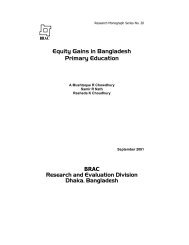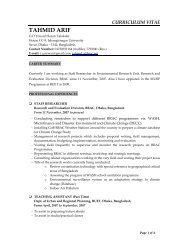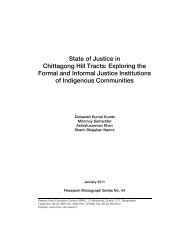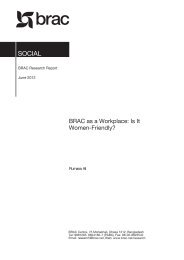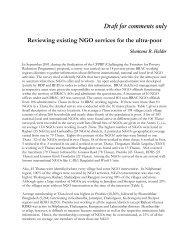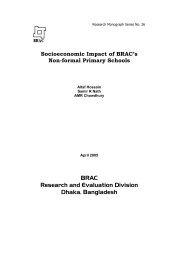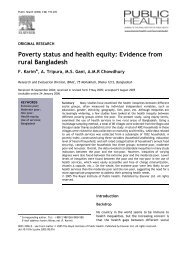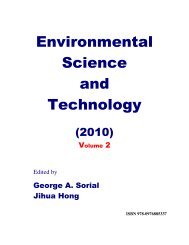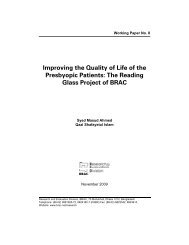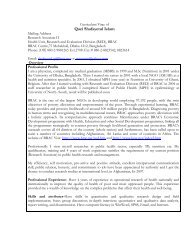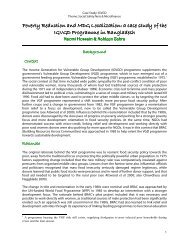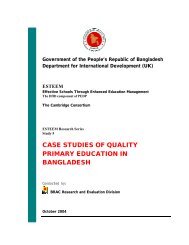Combining health and social protection measures to reach the ultra ...
Combining health and social protection measures to reach the ultra ...
Combining health and social protection measures to reach the ultra ...
You also want an ePaper? Increase the reach of your titles
YUMPU automatically turns print PDFs into web optimized ePapers that Google loves.
Decision-making<br />
The potentials of involving<br />
communities in <strong>health</strong> research<br />
Article by Selemani S Mbuyita<br />
“…We live, after all, in a world of increasing polarization of power <strong>and</strong> wealth in<strong>to</strong> North <strong>and</strong> South, in<strong>to</strong><br />
overclasses <strong>and</strong> underclasses. Materially, those in <strong>the</strong> overclasses have more <strong>and</strong> more, <strong>and</strong> are increasingly<br />
linked by instant communications. At <strong>the</strong> same time, <strong>the</strong> numbers in <strong>the</strong> underclasses of absolute poverty<br />
continue <strong>to</strong> rise. Among <strong>the</strong>m, many millions have less <strong>and</strong> less, <strong>and</strong> remain isolated both from <strong>the</strong><br />
overclasses <strong>and</strong> from each o<strong>the</strong>r. Almost by definition, <strong>the</strong> poor <strong>and</strong> powerless have no voice. It may be<br />
politically correct <strong>to</strong> say that <strong>the</strong>y should be empowered <strong>and</strong> <strong>the</strong>ir voices heard. But cynical realists will point<br />
<strong>to</strong> inexorable trends, vested interests <strong>and</strong> pervasive self-interest among <strong>the</strong> powerful, <strong>and</strong> argue that little<br />
can be changed” (Robert Chambers, Whose Voice?).<br />
For anyone who has been in research <strong>and</strong> applied any of<br />
<strong>the</strong> many b ranches of participa<strong>to</strong>ry research methods,<br />
turning back <strong>to</strong> <strong>the</strong> conventional empiricist survey<br />
approaches or any o<strong>the</strong>r “quick <strong>and</strong> dirty” data collection<br />
techniques would be difficult. The facts revealed, <strong>the</strong><br />
knowledge acquired <strong>and</strong> <strong>the</strong> skills unveiled from <strong>the</strong> people<br />
in communities where <strong>the</strong> research process is implemented,<br />
differentiate distinctly participa<strong>to</strong>ry research (that involves<br />
communities) from o<strong>the</strong>r research methodologies.<br />
Literally, participation can be defined in different ways.<br />
However, in general terms <strong>the</strong> concept of participation reflects<br />
<strong>the</strong> action of taking part in an activity. People “participate” in<br />
local development every day through <strong>the</strong>ir family life,<br />
livelihood activities <strong>and</strong> community responsibilities. The<br />
degree of control that men <strong>and</strong> women have over <strong>the</strong>se<br />
activities varies. The same holds true for initiatives that are<br />
initiated or involve “outsiders” such as research projects,<br />
development programmes or advocacy campaigns 2 .<br />
The potential of participa<strong>to</strong>ry research comes from <strong>the</strong><br />
researched people as active analysts of <strong>the</strong> researched<br />
subjects. With participa<strong>to</strong>ry research, solutions <strong>to</strong> research<br />
questions come from <strong>the</strong> people supported with data, <strong>and</strong><br />
not from data supported by trained data analysts.<br />
Interventions <strong>and</strong>/or programmes developed using data from<br />
<strong>the</strong> first scenario are more reliable, feasible <strong>and</strong> sustainable<br />
in <strong>the</strong>ir implementation than <strong>the</strong> latter. His<strong>to</strong>rically, <strong>health</strong><br />
policies that have been designed without a community<br />
Literally, participation can be defined in different ways.<br />
However, in general terms <strong>the</strong> concept of participation<br />
reflects <strong>the</strong> action of taking part in an activity. People<br />
“participate” in local development every day through<br />
<strong>the</strong>ir family life, livelihood activities <strong>and</strong> community<br />
responsibilities<br />
participa<strong>to</strong>ry approach, some of which have acquired a global<br />
attention, often have failed <strong>to</strong> solve people’s <strong>health</strong> problems.<br />
The trend will be <strong>the</strong> same <strong>and</strong> <strong>the</strong> vicious cycle maintained<br />
unless <strong>the</strong> participa<strong>to</strong>ry research community can succeed <strong>to</strong><br />
show, demonstrate, convince <strong>and</strong> prove <strong>to</strong> local <strong>and</strong> global<br />
<strong>health</strong> policy-makers that participa<strong>to</strong>ry research has <strong>the</strong><br />
potential <strong>to</strong> solve many of our <strong>health</strong> problems.<br />
To address <strong>the</strong>se concerns, special attention has been paid<br />
for <strong>the</strong> past few decades <strong>to</strong> <strong>the</strong> development <strong>and</strong> analysis of<br />
participa<strong>to</strong>ry research methods. One stream of participa<strong>to</strong>ry<br />
research, with new inventions, evolved as a family of<br />
approaches <strong>and</strong> methods known as Participa<strong>to</strong>ry Rural<br />
Appraisal (PRA). As PRA evolved, it soon became evident that<br />
it had applications for policy. Thematic <strong>and</strong> sec<strong>to</strong>ral studies<br />
were carried out <strong>and</strong> resent as reports <strong>to</strong> decision-makers,<br />
sometimes within only days or weeks of <strong>the</strong> field work. The<br />
World Bank, through trust funds from bilateral donors,<br />
initiated Participa<strong>to</strong>ry Poverty Assessments (PPAs). Some of<br />
<strong>the</strong>se used PRA methods <strong>to</strong> enable poor people <strong>to</strong> express<br />
<strong>the</strong>ir realities <strong>the</strong>mselves. The insight from <strong>the</strong>se <strong>the</strong>matic<br />
studies was striking, convincing <strong>and</strong> unexpected. However, it<br />
was (<strong>and</strong> still is) <strong>to</strong>o scattered <strong>and</strong>/or fragmented for full<br />
mutual learning or for its significance <strong>to</strong> be fully seen 3 .<br />
Health programmes that were later proposed <strong>and</strong><br />
implemented worldwide, with elements of involving<br />
communities in <strong>the</strong>ir implementation had <strong>the</strong>ir roots in<br />
evidence revealed by participa<strong>to</strong>ry research. Today, we<br />
identify programmes <strong>and</strong> interventions such as School Health<br />
Programmes, Community Based Health Initiatives etc. that<br />
were designed <strong>to</strong> respond <strong>to</strong> unveiled potentials of<br />
beneficiaries’ involvement in such programmes. For example,<br />
<strong>the</strong> concepts of <strong>the</strong> Health-Promoting School <strong>and</strong> of<br />
Comprehensive School Health Education <strong>and</strong> Promotion, as<br />
discussed <strong>and</strong> defined by WHO, have highly considered<br />
participation concepts 1 . Partly, this programme aims <strong>to</strong><br />
counter <strong>the</strong> views adults <strong>and</strong> teachers commonly hold of<br />
children <strong>and</strong> young people as ignorant-<strong>to</strong> be taught;<br />
176 ✜ Global Forum Update on Research for Health Volume 4



